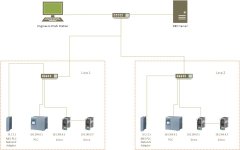Hi,
I'm trying to get my head around how plant networks should be set up, and I've created a few topics on this before.
One new question I have though is how do you connect everything in a certain area / cell to a remote engineers station?
So say in your factory you have 6 different productions lines / areas, and each line is a collection of different machines, would you create a network / VLAN for each area, which will allow an engineers server to connect to all of the devices on line like servos, cameras, etc? Or would you create just one machine VLAN for all areas and connect every device to that? This would obviously mean each device in the factory needs a unique IP address.
Currently on some of the machines we have a connection for remote access and MES connection to Kepserver, but that is usually on a different network to the machines network of inverters, servos, etc. What is the best way to access these remotely / from an engineers server?
I'm trying to get my head around how plant networks should be set up, and I've created a few topics on this before.
One new question I have though is how do you connect everything in a certain area / cell to a remote engineers station?
So say in your factory you have 6 different productions lines / areas, and each line is a collection of different machines, would you create a network / VLAN for each area, which will allow an engineers server to connect to all of the devices on line like servos, cameras, etc? Or would you create just one machine VLAN for all areas and connect every device to that? This would obviously mean each device in the factory needs a unique IP address.
Currently on some of the machines we have a connection for remote access and MES connection to Kepserver, but that is usually on a different network to the machines network of inverters, servos, etc. What is the best way to access these remotely / from an engineers server?




